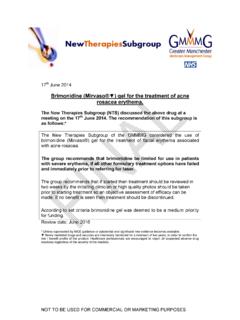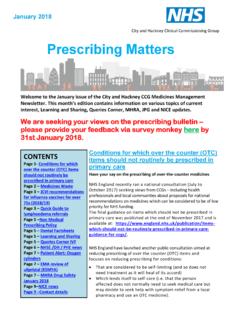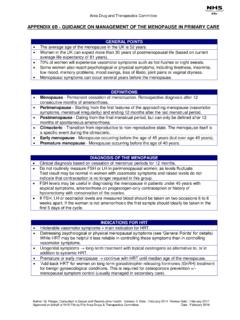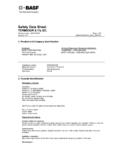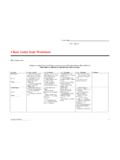Transcription of A DRAFTING GUIDE FOR 8(i) SETTLEMENTS
1 A DRAFTING GUIDE FOR 8(i) SETTLEMENTS LEWIS S. FLEISHMAN A. INTRODUCTION A primary Department of Labor complaint in longshore cases is the inability of the parties to draft an 8(i) agreement which complies with applicable statutes and regulations. It is the author's experience that between thirty and forty percent of 8(i) applications are initially rejected by the United States Department of Labor. A notice of deficiency generally issues when a proposed 8(i) agreement lacks an essential ingredient or contains an unacceptable "add-on" provision. A deficiency notice can be avoided by reference to the 8(i) checklists, the sample 8(i) agreement and the DRAFTING examples contained in the following article.
2 The main statutes and regulations regarding the settlement of claims are provided herewith for handy reference. Use of these materials will result in better 8(i) agreements and swifter approval. B. BASIC REFERENCE TOOLS FOR DRAFTING 8(i) AGREEMENTS The following materials found in this article serve as DRAFTING guides for preparing 8(i) agreements: 1. Section 8(i) of the Act; 2. 20 CFR through ; 3. 8(i) settlement checklist: 7th Compensation District; 4. 8(i) settlement checklist: 13th Compensation District; 5. Model 8(i) agreement; 6. Notice of Deficiency; 7. Notice re: SETTLEMENTS - medicare; 8.
3 settlement Agreements - ALJ hearing notice; 9. Sample medicare set-aside affidavit; 10. Industry Notice No. 117 Vocational Rehabilitation. 2 C. LIST OF COMMON MISSING 8(1) INGREDIENTS: THE RECIPE FOR REJECTION. A recent informal survey conducted at a Department of Labor District Office shows the following common missing ingredients resulting in a Notice of Deficiency. The list below is not meant to be all encompassing. Rather, it is a GUIDE for what needs to be included and the legal authority for inclusion. Regulatory citations are placed first so that the draftsman will remember that the content of 8(i) agreements is governed by statute and regulation, not whim and caprice.
4 1. (b) 1 - The parties need to list separate amounts for compensation and future medicals in the agreement. A combined lump-sum will not suffice. 2. (b)(7) - The parties need an itemization of past medicals by year for the past three years if future medicals are to be closed. Any agreement attempting to close future medicals should contain an estimate of future medicals. The parties may request a waiver of a doctor's estimate by pointing to existing medicals showing that claimant has been released from care or that he only need return "pm". The application should note whether recent medical expenses have been minimal or non-existent in the event that future medicals are to be closed.
5 3. (b)(6) - A detailed explanation of adequacy is needed. The explanation must be stated in dollar amounts. The old "best interests of the claimant" is not enough. The explanation must be based on the particular facts of the case. The parties should cite disputed facts and why the 8(i) adequate in terms of probable or possible outcomes. The explanation must be based on evidence in dispute, not speculation or fantasy. In a "waive and pay" combined 8(i)/third-party settlement , the net third-party recovery to claimant needs to be broken out so that there is a basis for determining adequacy.
6 The stipulation on adequacy should not list every office visit and physical therapy session that claimant attended. The medical information relevant to the issue of adequacy is what is important. Therefore, items such as initial treatment, hospitalization, positive tests, surgery, the attainment of maximum medical improvement, impairment ratings, physical restrictions and long-term prognosis should be included. 4. (a) - The summary of compensation or average weekly wage in the stipulation should match the information in the Department of Labor's file.
7 The Department of Labor will check the proposed 8(i) agreement against forms LS-208 in the administrative file. If there is a discrepancy, it will need to be reconciled. It is best to review this material before submitting the application, not later. 3 5. (b)1 and Section 28: settlement agreements often provide a specific attorney's fee for claimant's counsel. An application may well be held up until a fully documented fee application is submitted. 6. (a) and (b)(5): The parties need to include an impairment, or ppd rating, and permanent physical restrictions, if any.
8 These cannot generally be provided by a physician until claimant has reached maximum medical improvement (MMI). 7. (b) - The 8(i) agreement needs to be submitted to the right place. If the case is at the District Office level, it can be submitted to the proper USDOL office. If the case is pending at the Office of Administrative Law Judge level, the 8(i) agreement can be submitted to the Administrative Law Judge, or remanded to the District Office level for approval. 8. (b)(3) - The 8(i) agreement needs to contain a date of birth for the claimant, or the survivors if it is a death case.
9 9. (b)(4) - An agreement needs to contain the claimant's work, wage, earnings and educational history. If claimant has no actual wages post-injury, a labor market survey can prove suitable alternate employment. 10. 42 1395(y)(b) and 42 Medicare or Medicaid settlement considerations in an 8(i) agreement. (See attached description of Medicare/Medicaid considerations and sample affidavit.) D. COMMON 8(i) INGREDIENTS LIKELY TO CAUSE INDIGESTION: "ADD-ONS" RESULTING IN REJECTION. Just as the failure to include an essential ingredient will result in a notice of deficiency, the inclusion of an offending "add-on" provision will likely achieve the same result.
10 The draftsman who approaches an 8(i) agreement with the same mindset used in DRAFTING a third-party release will find the final work-product rejected. That is because the scope of an 8(i) agreement cannot approach the breadth of a personal injury release. Here are some of the more common offending provisions likely to cause rejection of an 8(i) agreement: 1. (g) - "Any and all claims" or "any and all accidents/injuries". The global release implies that, for example, a subsequent death claim would be settled by approval of the underlying inter-vivos injury claim. Since only claims in existence can be settled, these types of "kitchen sink" provisions will ultimately not pass scrutiny.


